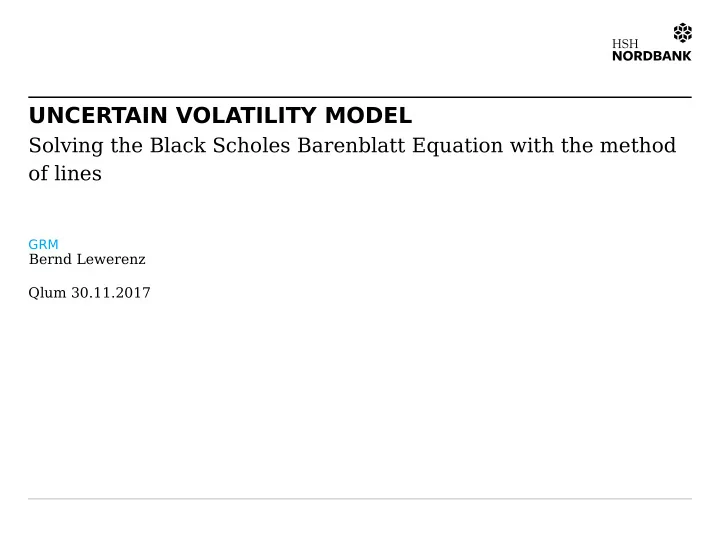

UNCERTAIN VOLATILITY MODEL Solving the Black Scholes Barenblatt Equation with the method of lines GRM Bernd Lewerenz Qlum 30.11.2017
Uncertain Volatility Model ● In 1973 Black, Scholes and Merton published there Option Pricing Model which later earned them the nobel price. Following this paper it was now possible to price options without the need to know the real world ● drift of the underlying asset. They were constructing a risk less portfolio that growth at the risk free rate. The problem which remained was the estimation of the volatility which is unknown and definitely ● not a constant. Ever since then people have concentrated to model the remaining parameter “Volatility”. ● However in 1995 Avellanada proposed a radical different approach by accepting the fact the ● volatility is unknown In my talk I follow this path of Avellaneda and approach this problem from a sell side perspective using the uncertain volatiliy model. It calculates a conservative price for an option portfolio given the option writer is willing to take ● on some risk in the black scholes delta hedging strategy. UVM ●
Disclaimer The content of this presentation reflects the personal view and opinion of the author only. It does not express the view or opinion of HSH Nordbank AG on any subject presented in the following. UVM 3 ●
Agenda 1. A simple Portfolio 2. Analysing the put spread 3. Motivation of the BSB Equation and the UV Model 4. Solving the BSB Equation with the method of lines 5. Results on our portfolio 6. Perspective 7. Numerical Details 8. References UVM 4 ●
A simple portfolio Lets consider a portfolio consisting of 2 plain vanilla put options: 1. A long position in a put option stroke at 110 EUR. 2. A short position in a put option stroke at 90 EUR. Both Options expire in 2 Years from now. The underlying of both options is a stock where we assume the following. 1) The riskless rate is at 0% and also the stock does not pay any dividends 2)We assume todays Spot Price of the Underlying beeing at 90 EUR A simple portfolio 5 ●
Payofg Profjle of our Portfolio A Simple portfolio 6
Sensitivity to Volatility (Black Model) We took the QL Black • Model. Then pricing the put spread • for a range of volatilities Analysing the put-spread 7 ●
Analysing the Put Spread There is no implied Black Volatitlity for this portfolio Here the vega is 0 Analysing the put-spread 8 ●
The underlying assumptions of the BSB Equation In Wilmott(2006) is ● assumed to calculate a ⁻ 2 more conservative Price where a trader should 2 sell the portfolio ⁻ ⁻ 2 ⁻ For calculating the best ⁻ ● 2 2 price (buy price) just 2 interchange the roles of σ(Γ)= { + if Γ≥ 0 + σ − σ σ and in the equation For a more rigorous − if Γ< 0 σ ● mathematical derivation σ − ≤σ≤σ + see Avellaneda (1995) Motivation of the BSB Equation 9 ●
Key Portfolio Indicators Bid Ask Spread UVM Bid Ask Spread Black Model Motivation of the BSB Equation 10 ●
Numerical Solution of the BSB Equation with the method of lines There are 2 methods of discretization: Space as shown in Hamdi (2007). This is the method we used ● here Time as shown in Meyer (2003). We wont show this method in ● this presentation ⁻ ⁻ 2 ⁻ ⁻ 2 2 2 c e S p a m e S p a c e T i The aim is to transform this PDE in a system of coupled ODEs which we then solve using the software in Ahnert (2011) ⁻ d V − = ( t , V ) f d t Solving the BSB Equation with the Method of Lines 11 ●
Operator for ODEint Solving the BSB Equation with the method of lines 12 ●
UVM Worst Price Surface Results on our portfolio 13
UVM Worst Price Gamma Surface Results on our portfolio 14
UVM Worst Price Delta Surface Results on our portfolio 15
Perspective ● The UVM PDE in non linear ● The present QuantLib ofgers pricing on an instrument level only and can not handle portfolio efgects as presented by the UVM (or CVA models) ● What could be further steps to raise the QL capacity to portfolio level? Perspective 16 ●
Numerical Details and Hardware Grid has 600 Steps in Asset Price Direction. • The grid spans from 1 EUR to 600 EUR in Asset Direction. • The solution inside the odeint integration at time steps of 0.02 Years. • The Bulirsch Stoer Stepper from ODEINT to integrate the ode system. • It took about 1.5 seconds to solve for the price. With 300 Asset Steps it took 0.25 seconds • The calculations were run on a pc running ubuntu. • The processor has been an intel i7-7700K with 16 GB of RAM • Numerical Details 17 ●
The Odeint Library within boost We use our nice friend library boost. It ships with a nice numerical package named odeint. ● The authors of Odeint were Karsten Ahnert and Mario Mulansky. ● There is a lot of documentation to be found at http://www.odeint.com ● Numerical Details 18 ●
References Marco Avellaneda, Arnon Levy, Antonio Paras, Pricing and Hedging Derivative Securities in Markets with Uncertain Volatilities,Applied Mathematical Finance, 1995 Paul Wilmott , Paul Wimott on Quantitative Finance (Vol III), John Wiley and Sons 2006 K. Ahnert and M. Mulansky, Odeint - Solving Ordinary Difgerential Equations in C++, AIP Conf. Proc. 1389, pp. 1586-1589 (2011) Gunter H. Meyer, The Black Scholes Barenblatt Equation for Options with Uncertain Volatility and its Application to Static Hedging, Int. J. Theoretical and Appl. Finance 9 (2006) Hamdi Sadeh, E. Schiesser William, Griffjths Graham, Method of Lines, Scholapedia (2007) Uncertain Volatility Model 11/27/17 19 19
Recommend
More recommend